Neonatal GI Physiology & NEC
Neonatal GI Physiology & NEC 5: Predicting Necrotizing Enterocolitis, Gut Health, and Oral Feeding
93 - Viral Infections and Neonatal Necrotizing Enterocolitis: A Systematic Review and Meta-analysis
Publication Number: 93.237

Srinivasan Mani, MD (he/him/his)
Clinical Assistant Professor
The University of Toledo College of Medicine and Life Sciences
University at Buffalo
Perrysburg, Ohio, United States
Presenting Author(s)
Background: Necrotizing enterocolitis (NEC) is a devastating intestinal disease affecting preterm infants with an incidence of 8-10% and mortality of up to 30%. Viral infections have been implicated in the etiopathogenesis of NEC.
Objective: To summarize the association of viral infections with NEC by performing a systematic review and meta-analysis of observational studies.
Design/Methods:
DATA SOURCES: We searched the electronic databases Ovid-MEDLINE, Embase, Web of Science, and the Cochrane library in November 2022.
STUDY SELECTION: We included observational studies that examined the association between viral infections and NEC in preterm and term infants. Case series and case reports were excluded.
DATA EXTRACTION AND SYNTHESIS: We performed the review based on MOOSE and PRISMA guidelines. We used the Newcastle-Ottawa scale to assess the risk of bias in included studies. A random effects meta-analysis was performed using the inverse variance method for computing odds ratio (OR) with (95% CI). We used Cochran’s Q test and I2 statistic to assess heterogeneity and Egger’s test to detect publication bias.
MAIN OUTCOMES AND MEASURES: The primary outcome was NEC (Bell stage ≥ 2) after the diagnosis of a viral infection.
Results: We screened 1102 studies, of which 33 were included in the qualitative review (number of participants,6814). Twenty-seven studies with 6346 participants provided data for the meta-analysis, which showed a diagnosis of a viral infection was significantly associated with NEC (OR= 3.08, 95% CI: 1.80 - 5.27, I2 = 81%, 27 studies). In sensitivity analyses, the association of viral infections with NEC remained significant after excluding the outliers (OR = 2.44, 95% CI: 1.47-4.06, 25 studies) and studies with poor methodology (OR = 2.75, 95% CI: 1.61-4.71, 25 studies) (Table 1). In subgroup analysis based on participants’ birth weight, studies including very low birth weight (VLBW) infants only (OR =2.73, 95% CI: 1.59- 4.70, 10 studies) and non-VLBW infants only (OR= 5.28, 95% CI: 1.69, 16.54, 6 studies) showed a significant association between viral infection and NEC (Fig. 1). In subgroup analysis based on specific viruses, infection with rotavirus (OR= 3.96, 95% CI: 1.12-13.95, 10 studies), cytomegalovirus (OR= 3.50, 95% CI: 1.60-7.65, 5 studies), norovirus (OR= 11.95, 95% CI: 2.05-69.84, 2 studies), and astrovirus (OR= 6.32, 95% CI: 2.49-16.02, 2 studies) was significantly associated with NEC, while HIV was not (Fig. 2).
Conclusion(s): Summarized evidence from observational studies shows that viral infection is associated with an increased risk of NEC in newborn infants. .png)
.png)

